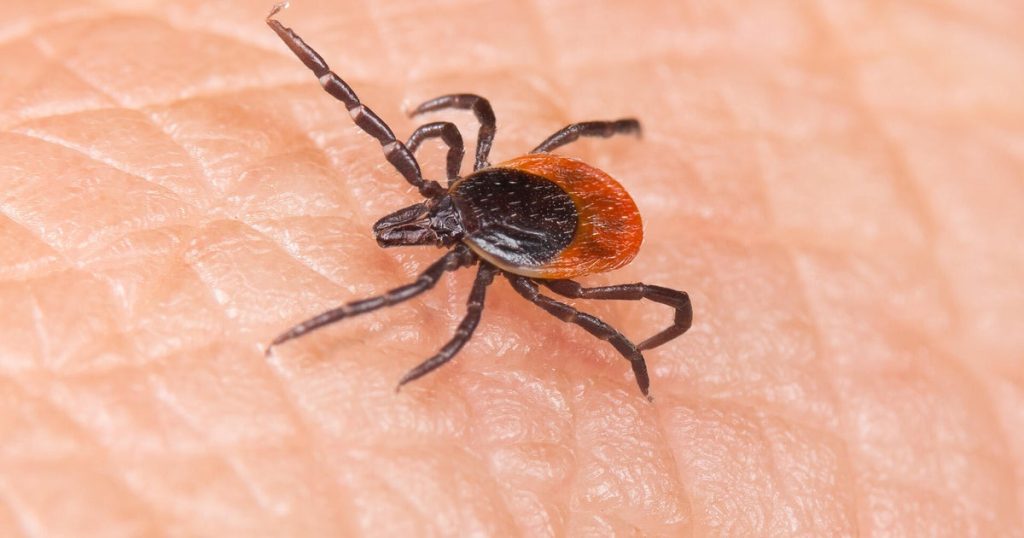Emergency room visits due to tick bites have surged to their highest levels since 2019, as reported by the Centers for Disease Control and Prevention. The increase is particularly alarming in the Northeast, where data shows a significant rise in tick-related cases this June compared to previous years. Experts attribute this spike to record-high populations of ticks and a prolonged tick season, exacerbated by climate change. With tick-borne illnesses posing serious health risks, authorities emphasize the importance of preventive measures to minimize exposure.
| Article Subheadings |
|---|
| 1) Surge in Emergency Room Visits |
| 2) Understanding Tick-Borne Illnesses |
| 3) Factors Driving the Increase |
| 4) Expert Recommendations for Prevention |
| 5) The Broader Public Health Implications |
Surge in Emergency Room Visits
This year, emergency room visits for tick bites are reported at alarming levels, reaching figures not seen since before the pandemic. The Centers for Disease Control and Prevention (CDC) indicates that the rate of tick-related emergency room visits has significantly increased, particularly in the Northeast region of the United States. During June 2024, the recorded instances reached 229 cases per 100,000 visits, a rise from 167 cases per 100,000 visits compared to the same month in the previous year. This surge raises significant concerns regarding public health and the implications of tick bites in the wake of rising tick populations.
Understanding Tick-Borne Illnesses
Ticks are notorious carriers of various diseases, which can lead to profound health issues for individuals who fall victim to bites. Among the most common illnesses associated with ticks is Lyme disease, which results from the bite of an infected black-legged tick (deer tick) carrying the bacterium Borrelia burgdorferi. Symptoms can vary in severity, including fever, chills, fatigue, and even severe joint pain. Additionally, ticks can transmit several other pathogens, including those responsible for babesiosis, anaplasmosis, and the Powassan virus disease. These illnesses emphasize the need for heightened awareness and preparedness, especially among populations in areas with high tick activity.
Factors Driving the Increase
Experts attribute the notable increase in emergency room visits for tick bites primarily to record-high tick populations across multiple states this season. According to Dr. Dennis Bente, a microbiologist and immunologist, this year has brought about an unprecedented spike in tick populations, which can directly correlate to increased human encounters with these pests. Additionally, the lengthening tick season, characterized by a warmer climate, means that ticks are now active throughout parts of the year that were once considered off-limits for tick activity. “We are also seeing a longer tick season across the country, which historically has been a relatively predictable seasonal threat,” noted Dr. Bente, advocating for year-round vigilance. This unfolding scenario indicates the increasing intertwining of climate dynamics with public health challenges.
Expert Recommendations for Prevention
As tick populations grow and diseases spread through bites, experts emphasize the importance of preventive measures. Dr. Céline Gounder, a medical contributor and public health editor, highlights that awareness of ticks and the diseases they carry is crucial for public safety. Protective strategies advised by health officials include wearing long-sleeved clothing and applying insect repellant when venturing outdoors, especially in areas known for high tick presence. Moreover, conducting thorough tick checks upon returning home is vital, with special attention to hidden areas such as the scalp, armpits, and groin. Dr. Bente emphasizes that these tick checks are the “most critical prevention measure,” recommending the use of mirrors for examination in areas where ticks are likely to hide.
The Broader Public Health Implications
The rising tick populations and increased tick-borne illnesses highlight significant public health issues that warrant attention. Dr. Bente expressed concern about ticks being referred to as “sneaky opportunists,” as they often lurk in bushes and grasses, waiting for unsuspecting passersby. He noted, “Most people don’t realize that ticks transmit more viruses and diseases than any other animal in the world, so this rapid increase in population is a serious concern for public health.” As the climate changes, tick habitats and lifecycles are also adapting, leading to rising exposure levels in areas previously unregulated. This shifting dynamic necessitates comprehensive strategies and public health initiatives to mitigate risks associated with tick bites and enhance general awareness among the population.
| No. | Key Points |
|---|---|
| 1 | Emergency room visits for tick bites have surged to historic levels this year. |
| 2 | Ticks are carriers of multiple serious diseases, including Lyme disease and the Powassan virus. |
| 3 | Rising tick populations and extended tick seasons attribute to the increase in bites. |
| 4 | Health experts advocate for preventive strategies, including clothing and ticks checks. |
| 5 | The interaction between climate change and health risks emphasizes the need for public awareness. |
Summary
The increase in emergency room visits due to tick bites reflects a growing public health concern driven by various factors, including climate change and elevated tick populations. With the potential for severe health implications from tick-borne illnesses, it is essential for the public to remain vigilant and follow recommended preventive measures. Health officials stress the importance of being proactive about tick exposure, as the interaction of environmental changes with human health issues continues to evolve.
Frequently Asked Questions
Question: What are the main diseases transmitted by ticks?
Ticks can transmit several diseases, most notably Lyme disease, babesiosis, anaplasmosis, and Powassan virus disease. These diseases can lead to serious health complications if left untreated.
Question: How can one effectively prevent tick bites?
Effective prevention starts by wearing long-sleeved clothing, using tick repellants, and performing thorough tick checks after being outdoors, especially in areas known for high tick activity.
Question: Why is there an increase in tick populations this year?
This year’s increase in tick populations is largely attributed to milder winters and wetter springs, which create favorable breeding conditions for ticks, alongside a prolonged active season due to climate change.


